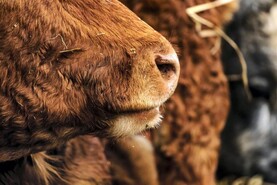Recently, I went to visit China’s largest standalone beef unit, which boasts 11,000 suckler cows and between 30,000-40,000 steers at any one time.
The state-owned business, named Chengkai is based in Jilin Province in the northeast of China, which was traditionally a stronghold for cattle farming.
Chengkai is a state-owned company that was traditionally focused on construction projects, but since 2020 they have piled over €407m into a major farm and processing facility.
On the way to visit the mega-farm, we stopped in a village and found a local restaurant. In a place that rarely sees westerners, other diners in the restaurant tried to spark conversation.
The locals were also cattle farmers and asked if it was true that beef prices in Brazil are as low as US$1.50/kg of beef. They seemed exasperated that the price of beef in Brazil is far higher than their costs.
These farmers were struggling with losses, that subsidies they were expecting didn’t fully materialise and that they were expecting another hard year or two before the ‘market turns’.
Generally, in the midst of a bad market, people here are always hoping for better days or for a return to the heady days when Chinese beef farmers could make record margins even if they weren’t very efficient.
But from a government perspective, the market being flooded with cheap beef from South America is seen as a positive for food security. It means that more people can eat less expensive beef and provide more choice as the economy slows.
The trend is likely to accelerate, and Chinese consumers can expect to continue to take advantage of cheaper beef, as well they should.
So what for the mega-farm? Mr Wei, the farm manager was introspective. His view is that the future of China’s domestic beef industry should more closely reflect Korea and Japan, where a small domestic industry supplies between 20%-30% of the overall market requirement.
Within that context, Mr Wei sees a bright future for large scale farming in the beef sector in China, and at the same time he foresees a significant demise of the small backyard farm.
If you play out Mr Wei’s hypothesis, it may mean half of China’s cattle would be culled. However, the problems the large scale units are facing are particularly acute on the suckler cow side, as they are keeping the cows in a confined system.
Struggling
The farm is losing €850 per cow per annum on average and is struggling with calving, with body condition and with trying to find the right way to control feed costs.
When we walked the farm, there was no feed available in front of the cows and the mixture of imported Angus, Hereford and local Simmental cows all seemed to be under-conditioned.
Chengkai, like other larger players in China, is focusing on the premium market, shifting their genetics to Angus and Wagyu-cross and is slowly growing a brand based on quality.
Their target is the top 20% segment of the Chinese market, and Mr Wei said jokingly that he is competing with Ireland, Australia and America for the top end of the market.
But this is the only route for large scale cattle farming in China. That night, we went to a high-end beef hotpot restaurant featuring marbled beef.
All of this meat was from Australia and the United States. Asking the restaurant manager, they only consider imported beef due to quality and consistency requirements.
The following morning I had a run around the local village and saw some lovely Simmental cows sitting outside a typical multipurpose farm operation with maize corn, vegetables and some cows.
The cows were comfortable, and unlike the cows in the mega-farm, they were lying down chewing the cud.
The industrialisation of agriculture is inevitable, but it doesn’t always mean that it will be better.
Putting suckler cows in confined systems just seems to go against the basic rules of animal husbandry and economics. The evolution of China’s domestic beef industry continues to be an interesting experiment in animal husbandry.






 This is a subscriber-only article
This is a subscriber-only article










SHARING OPTIONS: